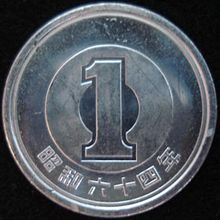1 yen coin
This article needs additional citations for verification. (March 2010) |
Japan | |
| Value | 1 Japanese yen |
|---|---|
| Mass | 1 g |
| Diameter | 20 mm |
| Thickness | 1.5 mm |
| Edge | Smooth |
| Composition | 100% Al |
| Years of minting | 1955–present |
| Obverse | |
 | |
| Design | young tree |
| Design date | 1955 |
| Reverse | |
 | |
| Design | "1" in a circle with year of issue in kanji |
| Design date | 1955 |
The 1 yen coin (一円硬貨, Ichi-en kōka) is the smallest denomination of the Japanese yen currency. The first Japanese one yen coin was minted in 1870. The current design was first minted in 1955.[1]
Current design
The front of the current aluminium one yen coin has the figure "1" in a circle with the year of issue[clarification needed] in kanji below, and the reverse side has a young tree, intended to symbolize the healthy growth of Japan.[1]
History

The first Japanese one yen coin was minted in 1870. Its obverse featured a dragon with a circular inscription around. The reverse had a radiant sun surrounded by a wreath, with chrysanthemum emblem (a symbol of the Japanese Imperial Family) flanked by floral patterns above. Large silver one yen coins were issued between 1870 and 1914, supplemented by small gold one yen coins issued between 1871 and 1880 (plus a special collector's issue from 1892). One yen silver coins minted after Japan adopted the gold standard (gold based currency) in 1897 were not issued for domestic use, but for use in Japanese Taiwan and foreign trade.[citation needed]
A brass one yen coin was minted during 1948–50.[citation needed]
The current design was introduced in 1954, when the first aluminium one yen coin was minted.[citation needed]
Non-monetary use

Since all 1 yen coins weigh 1 gram, they are sometimes used as weights.[2] If placed carefully on the surface of still water, 1 yen coins will not break surface tension and thus can float.[citation needed]
References
- ^ a b "Circulating Coin Designs". Japan Mint. Retrieved 7 March 2010.
- ^ http://www.stippy.com/japan-life/fate-of-the-1-yen-coin/


